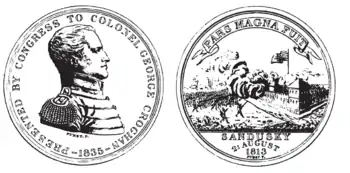George Croghan (soldier)
George Croghan (November 15, 1791 – January 8, 1849) was an American soldier. He was born at the Locust Grove farm in what is now Louisville, Kentucky and died in New Orleans, Louisiana. He was a recipient of the Congressional Gold Medal.
George Croghan | |
|---|---|
 George Croghan | |
| Born | November 15, 1791 Louisville, Kentucky |
| Died | January 8, 1849 (aged 57) New Orleans, Louisiana |
| Allegiance | |
| Service/ | |
| Years of service | 1811–1817, 1825–1849 |
| Rank | |
| Commands held | Inspector General of the U. S. Army |
| Battles/wars | War of 1812 |

Early life and family
George Croghan was born in Louisville, Kentucky. His father was William Croghan a Catholic of Dublin, Ireland, and he had served in the Revolutionary War at the battles of Brandywine and Monmouth.[1] His mother was Lucy Clark Croghan. She had two brothers who achieved renown: Captain William Clark and General George Rogers Clark. Croghan married Serena Livingston, a granddaughter of Robert Livingston (1718–1775) of Clermont Manor in New York.
Education and career
Croghan studied at the College of William and Mary and joined the army after he graduated in 1810. He fought at the Battle of Tippecanoe in 1811. He also served at Fort Meigs (modern Perrysburg, Ohio) with distinction. For his defense with a small garrison against a British attack during the Battle of Fort Stephenson, Ohio, in 1813 during the War of 1812, he was promoted to the rank of lieutenant colonel. He later led a troop that was defeated in the Battle of Mackinac Island.
Following the war, Croghan resigned from the army during a reduction in force and was appointed as a postmaster in New Orleans. In 1825, he became one of the two inspector generals in the army. During the Mexican–American War Croghan fought as a colonel at Monterrey.
Croghan died in the cholera epidemic of 1849, which had high mortality rates. Former President of the United States James K. Polk also died in the epidemic. It is believed that later in life Croghan had a problem with alcoholism. But he was cordial and considered to be very much a gentleman.
Legacy and honors
Colonel Croghan is buried at the site of Fort Stephenson, in what is now Fremont, Ohio. The former fort site was preserved in a parklike setting, where the main public library was constructed. Croghan's tomb and a soldiers' memorial to the war installed by the DAR in 1903 are both located on the library grounds near Croghan Street, which was renamed in his honor.
The village and town of Croghan, New York are also named after him.[2]
References
- Meek, Basil. Twentieth Century History of Sandusky County, Ohio. Chicago: Richmond-Arnold Publishing Co., 1909.
- Gannett, Henry (1905). The Origin of Certain Place Names in the United States. Govt. Print. Off. pp. 96.
- Sandusky County Soldiers' Monument Association (1885). Proceedings at the Unveiling of the Soldiers' Monument on the Site of Fort Stephenson, Fremont, Ohio. Fremont, Ohio: The Democratic Messenger. pp. 102–103.